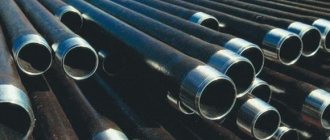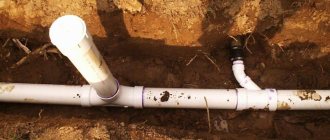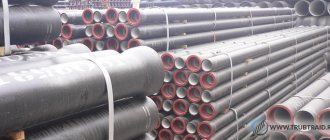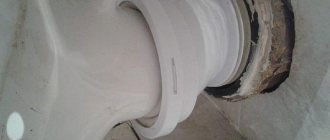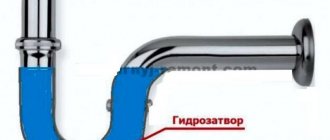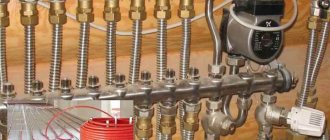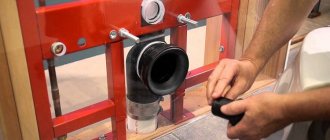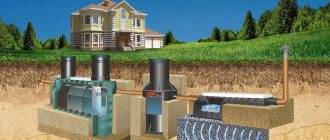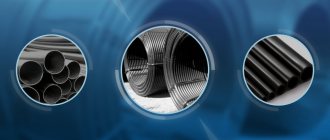When everything has become more or less clear with the internal arrangement, you should note that the sewage system outside the living space will have slightly different parameters. Moreover, these are not just desirable dimensions, but a standard that must be met, otherwise it will hardly be possible to connect with the central sewer system.
Table 2 Dimensions of cast iron or plastic pipes for external sewerage
| Installation location | Diameter (mm) |
| External main pipeline | 110-160 (depending on the diameter of the risers) |
| Baths and saunas | 150-200 |
| Swimming pools | 200-300 |
Thus, today it is much easier than before to install a sewer system in accordance with all the rules, requirements of technical specifications and GOSTs, since all information about the sizes of plastic and cast iron sewer pipes is freely available and it is not difficult to find it if you set such a goal. By doing everything according to the rules, you can avoid many problems in the future, for example, when you need to repair a breakdown or completely replace outdated or failed pipes.
PVC, PP and PET pipes
All pipes made from polyvinyl chloride are subject to certain standards. These are two specific GOSTs: R 51613-2000, as well as VSN 48-96. Moreover, such plastic products can be both pressure and non-pressure. The former can and are allowed to be used in the construction of water supply systems where there is pressure, while the latter are intended exclusively for sewerage and drainage, in which pressure is not provided and the liquid itself drains under the influence of gravity. Let's look at the standard sizes and diameters of pipes, as well as the slopes that they need to be given for non-pressure types and types.
Table 3 Standard sizes of PVC sewer pipes
| Device | Slope | Distance between drain and siphon (cm) | PVC pipe sizes |
| Central riser | 100 | ||
| Central riser bends | 65-75 | ||
| Bath | 1:30 | 100-130 | 40 |
| Shower | 1:48 | 150-170 | 40 |
| Combined drain | 1:48 | 170-230 | 40 |
| Toilet, bidet | 1:20 | 70-600 | 30-100 |
According to building regulations, sewer pipes of this order most often have standard sizes of 50, 90 and 110 millimeters in diameter. At the same time, the wall thickness of such a product is only 3.2 millimeters, but the length can vary from half to eight meters. The total number of standard sizes of sewer pipes made of polyvinyl chloride or polypropylene is thirteen varieties. It is clear that the smallest ones, with a diameter of up to 75-100 mm, are used inside buildings, 100-110 mm outside, but 200-300 mm are suitable for creating a main sewer system.
Regarding polyethylene, from which sewer pipes are also produced today, they are produced in accordance with the requirements of GOST 22689.2-89 and have only four main and only varieties.
- 40 millimeters.
- 50 millimeters.
- 90 millimeters.
- 110 millimeters.
Such low-pressure products, regardless of diameter, will have a wall thickness of three millimeters, and for high pressure, five.
Cast iron pipes
Cast iron pipes are more reliable and durable, but at the same time, they are very heavy, which makes them difficult to transport and lay. According to their functional purpose, such metal pipes are divided into two main types.
- SME cast pipes are distinguished by the presence of a bell (expansion) at one end, while the other is usually smooth. This device greatly simplifies the assembly of the pipeline.
- SMU pipes are absolutely smooth, and their joining requires special, additional elements.
Table 4 Standard sizes of pipes and sockets
| Casting element (pipe) | 50 mm | 100 mm | 150 mm |
| External diameter (D) | 58 | 109 | 160 |
| Thickness (S) | 4 | 4.5 | 5 |
| Bell diameter | 65 | 113 | 168 |
Despite the fact that the wall thickness, diameter and other indicators of cast iron sewer pipes are not much different from polymer ones, their weight differs significantly. So one meter of a hundred-millimeter cast iron pipe will weigh all fourteen kilograms, versus one and a half kilograms of plastic ones. Today, installing a sewage system at home is much easier, and even if you choose cast iron, you just need to enlist the help of real professionals. They not only have practical experience in laying sewers, but also all the necessary equipment for this.
Types of plastic sewer pipes
There are 4 types of material:
- polyethylene;
- polyvinyl chloride;
- polypropylene;
- metal-polymer.
Each type has its own characteristics and technical characteristics that should be taken into account when choosing.
Polyethylene can withstand high pressure up to 16 atmospheres and temperature changes from -40 to +40°C. However, this type has a drawback: you should not pour hot water over such products, as they may not withstand the temperature.
Polyvinyl chloride will be an excellent material for the construction of a sewer system. It is resistant to high temperatures and pressure up to 46 atmospheres. Such pipes are fireproof, withstand chemicals and do not conduct electricity.
Polypropylene material is used both for the installation of sewerage systems and for hot water supply, so this type of product can withstand temperatures up to +110°C. Maximum pressure - 20 atmospheres.
Metal-polymer pipes are the strongest and most durable of all of them. They easily take the desired shape, connect and cut. The operating temperature for this material is up to +90°C, and the inner layer of aluminum protects it from corrosion.
Classification of structures
There are different types of products in question. They are classified not by size parameters, but by the loads they can withstand. Each type of product is labeled accordingly.
The letter N indicated on the product indicates that the structure has a ring stiffness of 4 kN per m2. If S is present on the marking, this means that the above parameter has a value of eight.
There is the following product categorization system:
- SDR34 series S16.7, SN-8 - products with increased rigidity. Able to withstand high soil pressure. Excellent for installation under high load conditions.
- SDR41 series S20, SN-4 - these structures can be laid under roads with low traffic.
- SDR51 series S25, SN-2 - the simplest version of the products. They can only be used in conditions of low loads on the surface of structures.
Note that products intended for external sewerage have a number of differences from analogues used for arranging internal branches of the system. Most often, the structures under consideration are single-layer or smooth-walled. There are also three-layer and corrugated versions of products.
The latest version of the pipe product is characterized by a different topography of both the outer and inner surfaces. These structures are produced using the extrusion method. Corrugation made from unplasticized raw materials acts as a protective material. It increases strength indicators. The inner surface of such pipes is smooth. Therefore, its throughput is high.
Dimensions and diameters
For each purpose there is a different size and type of plastic sewer pipes.
Polypropylene comes in diameters of 32, 40, 50 and 110 mm, length can vary from 150 to 3000 mm.
Polyethylene is produced in diameters of 40, 50, 90 and 110 mm. The diameter of PVC pipes can be from 10 to 315 mm, and the length - from 4 to 12 m.
Dimensions of sewer plastic pipes 110 mm for free-flow sewerage:
- length including socket: 560, 1000, 2000, 3000, 4000, 6060 mm
- outer diameter: 110 mm
- internal diameter - 103.6 mm
- wall thickness 2.7-3.2 mm
- socket diameter: 125 mm
- OD/ID: 110/103.6 mm
- socket length: 60 mm
How to choose a diameter for connecting plumbing fixtures
Parameters for designing a sewerage system:
- slope;
- turns: their number and angle;
- methods of connecting pipes to each other, to fittings and to plumbing fixtures.
The choice of diameter for plastic sewer pipes depends on what they will be used for. For example, a toilet drain requires a diameter of 100 millimeters or more, since a large volume of water must pass through the pipe in a short period of time. There may be solid elements in the water that will not pass through the smaller diameter.
For the bathroom and kitchen, a size of 50 mm is suitable. Although a lot of water must pass through, it drains much more slowly, so a larger diameter is not needed here.
- 100 mm will be enough to organize a sewer system in a house or apartment in which the number of plumbing fixtures does not exceed a reasonable number.
- For bathrooms, a sewer pipe with a diameter of 50 mm is suitable - the size will be sufficient for plumbing fixtures.
- For buildings of 5 floors, a diameter of 100 mm is used; if there are more floors, then the size is increased to 150 mm.
- A common drain system with several risers and an exit to the well are mounted from 200 mm pipes.
Selection of wall thickness
One of the important parameters for the reliable functioning of sewer pipes is their thickness. As water passes through the drain, it exerts internal pressure on the walls. Therefore, the thickness must be such that the walls can withstand the pressure exerted on them. But it should be noted that when draining the sewer, the water flows by gravity, there is no great pressure on the walls, and therefore a significant thickness is not required.
Basically, the wall thickness of external sewer pipes is determined by their diameter. Traditionally, the thickness of pipes with a diameter of 110 mm is 3 mm. If the diametrical cross-section is 150 - 160 mm, then their thickness is about 3.9 mm. This thickness is functionally of great practical importance. For example, if a meter of 3 mm steel pipe with a diameter of 110 mm weighs 1 kg, then a 3.9 mm thick one with a diameter of 160 mm will already weigh about 2 kg.
As for plastic materials, the dependence of the parameters of thickness and diameter remains the same. The manufacturing process of PVC pipes is not complicated and, if necessary, you can change the thickness of the pipes during production.
Advantages
Plastic pipes can be used both for external and hidden installation, as they look aesthetically pleasing and are not conspicuous. There is no need to paint them, and the audibility of flow movements in plastic is much lower than in metal.
Plastic will last a long time. Even at low temperatures it is resistant to impacts and high soil pressure. The smooth surface of the pipe helps sewage drain faster and more efficiently, allowing it to withstand high water pressure. It also reduces the risk of blockages and damage even when moving dense elements. The low roughness coefficient prevents deposits of limestone and other decay elements, which provides greater strength.
This material is resistant to corrosion, changes in wastewater temperature and melting processes, salts, lime deposits, mineral acids and alkalis. In a private home you will have to deal with this yourself, and this is energy-consuming.
Low weight facilitates the transportation process. It is not necessary to order a car for delivery. Installation will not take much time; installation for a private home can be done independently, since the process is simple and does not require special knowledge.
Criterias of choice
To choose the right material for sewer installation, you must consider the following parameters:
- temperature regime of the region - the stronger the frost, the more stable the material should be;
- depth of laying in the ground and degree of soil mobility, as well as the presence of vibrations;
- pressure or non-pressure sewerage - pressure sewer requires material with thicker walls;
- internal or external system;
- Is sound insulation necessary - cast iron reduces sound waves well, plastic does not remove them.
One of the selection criteria is price, but saving on installation or connecting elements is not recommended. Poor quality parts may reduce service life or lead to repair costs.
Carrying out installation
To install the sewer system, a special trench is laid outside the building. Its depth should be below the freezing level of the soil. After this, the pipes are inserted into a special sleeve in the foundation, all components are joined, and then connected to the internal sewerage system. When laying non-pressure pipes, joints are treated with tarred tow or reinforced with rubber rings.
The sewage system is connected to a cesspool, septic tank or concrete overflow well. After checking the connections for leaks, thermal insulation is performed with a special material, then everything is covered with sand, compacting it in layers.
Installation of internal sewerage: after preparatory work and adjustment, a sewer riser is installed, after installing the tee, vertical pipes are inserted, then connections to the plumbing are made.
Connection Features
The connection can be made with or without hot soldering.
The advantage of soldering connections is tightness and reliability. The disadvantage of this method is that it will be difficult to dismantle quickly.
The second method uses sockets, that is, a pipe of a smaller diameter is inserted into a larger one and fixed. A threaded connection is also used: they screw one pipe into another, however, when installed near a wall, it will be difficult to tighten the threads properly.
Advantages of PVC pipes with a diameter of 110 millimeters
After plastic has been tested for many years in a variety of construction and industrial fields, it has also become popular in the laying of sewer systems.
Nowadays, no one doubts the high quality of such a product. Its merits are difficult to dispute. The most important advantages of a 110 mm pipe are:
- Elasticity . The product has the ability to deform under high pressure or mechanical stress. Moreover, the surface of the pipe does not crack, it simply receives forced curvature. Reliability in this case remains unchanged.
- Not afraid of corrosion . Any plastic will never rust. Fungus does not appear on its surface. Does not rot. PVC products do not react with aggressive substances and various detergents. The temperature regime of such products is in a very wide range. Severe frost or heat does not affect the properties of the material.
- Light weight . A 110 mm PVC pipe weighs 10 times less than its cast iron counterparts. Therefore, transportation and installation of the sewer system is much faster.
- Absolutely smooth surface inside , on which dirt is never deposited and does not become a source of unpleasant odor.
- Easy processing . They can be easily sawed with a regular hacksaw for working with metal.
- Fireproof . When a pipe enters an open flame, it begins to melt. Plastic is a non-flammable material, so fire does not occur.
- Comes with a large number of fittings . Thanks to this, wastewater disposal is created in apartment buildings.
- Low cost . Steel counterparts are estimated to be 10 times larger than any plastic pipe.
General information about types of pipes
There is a huge selection of this material on the market. Let's consider all types of products for sewerage.
Sewer pipes are made of PVC, Cast Iron, Polypropylene, Polyethylene.
Cast iron pipes
Now this manufacturing material has lost ground, giving way to new technologies. But it’s worth giving credit to cast iron. Not every material can compete with its strength and durability.
The main advantages of cast iron pipes
- Long service life
- Rust resistance
- Large temperature range
- Cast iron does not ignite
- Does not harm the environment
Minuses
As for the shortcomings, alas, they also exist.
- The material is not plastic, it is fragile in bending
- Requires grounding installation
- Weight. Cast iron is heavy - this greatly complicates installation.
Cast iron products are available in two formats
- With bell
- Smooth
GOST standards
All products are cast in accordance with GOST
GOST - 6942 - these are pipes for sewerage with standard parameters: 50,75,100 mm. The largest diameter is 400 mm.
GOST – 9583 – these are cast pipes with other diameters. They are usually used for sewer pipelines where the pipes are 1000 mm.
There are cast iron pipes on the market, cast using new technology; they have flexibility close to carbon steel. The price of these products is much higher than usual.
PVC sewer pipes
PVC is an excellent alternative to cast iron
Pipes made of this material are especially popular when installing external sewage systems.
Advantages
- Not exposed to aggressive environments
- Corrosion is completely eliminated
- No electrical conductivity
- Lungs.
POLYVINYL CHLORIDE is close in density to water
Flaws
- Possible damage if temperature rises above 75 degrees
- The material is fragile.
PVC pipes are also manufactured according to GOST
GOST – 51613 provides a diameter from 10 mm to 315 mm
Orange-colored pipes are used for assembling external sewage systems
When installing an internal drainage system, gray pipes are used.
Color acts as an indicator of strength.
Polypropylene pipes
Products made from this material have a wide range of applications.
Advantages
- Material resistant to various types of chemicals
- High elasticity
- Tolerates high temperatures well
- These pipes are widely used for installation of internal sewerage systems.
For the external sewer system, so-called corrugated pipes are used.
Polyethylene pipes
This material has good elasticity and strength.
Advantages
- The system can be easily rotated without the use of fittings
- Does not form cracks when frozen
- Well adapted to aggressive environments
Flaws
- Not stable at temperatures above 85 degrees
This type of product is produced in accordance with GOST - 22689.2.
Recommended pipe sizes
The choice of parts for sewerage depends on their purpose and size.
For internal sewerage
Plastic structures are selected based on established norms and rules.
| Purpose of parts | Inner diameter of pipes, mm |
| Washing machines and dishwashers | 25 |
| Bathtub, bidet and sink | 30-47 |
| Kitchen sink, shower and bathtub | 38-50 |
| Joint drainage (shower, sink, bathtub), system wiring inside the house | 50 |
| Riser bends | 70-86 |
| Central riser and toilet | 100-118 |
For external sewerage
| Purpose of parts | Inner diameter of pipes, mm |
| Discharge of wastewater to treatment systems | 150-190 |
| Bath, sauna | 200 |
| Pool | 240-300 |
| City sewer lines | 300-1100 |
In this case, it is necessary that the size of the horizontal pipeline matches, but does not exceed the diameter of the riser, otherwise blockages will form. Wide pipes are chosen for installing a toilet flush, since wastewater of heterogeneous composition passes through them. If a vacuum forms in the plastic outlet, the sewer system will malfunction. The gap will allow air under pressure to be forced out.
Plastic pipes for external sewerage.
Questions and answers
Why is a diameter of 110 millimeters considered optimal?
This value is a standard. To connect the toilet to the sewer system, 110mm pipes are used. This diameter is relevant for all types of products. Manufactured according to GOST. Meets all standards. There will be no problems when installing with different diameters. A diameter of 110 mm is considered the best for a standard type sewer system.
What material is best to assemble the pipeline from?
The answer to this question is obvious. Plastic.
Pipes made from this type of material are leaders in all respects.
- Wear resistance
- Corrugated products can be laid underground to a depth of up to 8 m
- Maximum pressure 6-16 Bar
- Temperature range from 65 to -10 degrees
- A light weight
- Tensile limit 50 MPa
- Service life up to 50 years
- High flexibility
- Easy installation
Manufacturing materials
Plastic is a budget-friendly, durable, lightweight material.
Steel, cast iron, concrete are heavy materials for arranging a sewer system. Its installation will require the use of construction equipment, which will entail additional costs. In addition, the internal surface is not perfectly smooth, so organic matter remains on the walls and over time forms plugs that will have to be cleaned.
Plastic pipes have a smooth inner surface and do not oxidize. If the pipeline is installed according to all the rules, it will be difficult for organic substances to attach to the walls. As a result, the line will require less maintenance costs, and sometimes there will be no need to clean or repair it at all.
To weigh the pros and cons, you need to evaluate the characteristics of all available materials and choose the appropriate one.
Polyethylene HDPE
Low-density polyethylene is a fairly durable material, especially its newest modification PE 100. It is suitable for embedding in concrete and laying in the ground, but the joints must be made using a welding machine required to work with PE 100, otherwise they may separate during operation and expensive repairs will be required.
The advantage of polyethylene is that when the water inside freezes, the pipe expands but does not burst. When thawed, it returns to its normal shape. In the northern regions, products are additionally insulated with laminated basalt stone wool before being laid in the ground.
A 110 mm polyethylene pipe can be used in pressure and free-flow sewerage, as well as in pressurized water supply systems.
uPVC
Unplasticized polyvinyl chloride (UPVC) – used in pressure and non-pressure systems. The service life is about 50 years, which is comparable to the maximum service life of steel structures. Suitable for transporting relatively hot liquids. Withstands temperatures from -50 to +78 degrees. uPVC is considered an environmentally friendly material, as it does not release harmful substances into the environment or drinking water. A pipe with a diameter of 110 mm with a socket connection system is used for casing artesian wells up to 300 m deep. uPVC does not affect the taste characteristics of water.
Unplasticized polyvinyl chloride is not flammable and has low thermal conductivity. PVC-U pipes for external sewerage are one of the most correct solutions in terms of price and quality.
Ceramics
Ceramics is a durable material, but joining and laying it is difficult.
The raw material for the production of ceramic water and sewer pipes is environmentally friendly - it is clay. Under the influence of high temperatures, products are strong and durable. They are not expensive to produce, so 110 mm ceramic pipes successfully compete with plastic ones.
The material does not react to sudden temperature changes and tolerates heat and severe frosts well. To prevent the water inside from freezing, it is necessary to additionally insulate the street section of the highway. Ceramics are not subject to corrosion, and pipes with a diameter of 110 mm are glazed on the inside for additional protection against aggressive chemicals and organics.
Polypropylene
110 mm pipes made of type 3 polypropylene have increased strength characteristics and are resistant to thermal influences - they can withstand temperatures of up to 110 degrees for a short time. Chemically inert to acids and alkalis, therefore they are well suited for sewerage installations. The material tolerates low temperatures worse - a maximum of minus 10 degrees, so polypropylene is insulated for laying in the ground.
Steel
Steel wiring is most often made for city sewerage, since the material has increased strength characteristics and can be used in conditions of vibration and ground movement - under highways. For home systems, such material is rarely used due to the large weight of steel products. To install them you need to use special equipment.
Steel is not resistant to corrosion; in addition, organic waste and mineral deposits remain on the pipe walls and reduce throughput. Anti-corrosion coatings do not provide a complete guarantee of high-quality work, as they wear off over time. 110 mm steel pipes are gradually being replaced by plastic ones, as they have approximately the same service life.
Polyvinyl chloride
110 mm PVC pipes are designed for operation in a limited temperature range - from 0 to 45 degrees, which does not always suit consumers. They are mainly used for transporting cold tap water. In addition, they must be insulated during the winter period.
PVC pipes are produced in a limited diameter from 110 to 200 mm, so they are suitable for home construction, but larger sizes are required for capital construction.
Non-pressure PVC sewer pipes must be laid in the ground in compliance with all the rules for connecting the end parts and the slope of the pipeline.
Concrete
Reinforced concrete pipes can be laid to great depths - up to 6 meters. They withstand the pressure in the system, therefore they are used in pressure sewer lines - private or urban.
The service life of reinforced concrete is more than 80 years with proper operation and timely maintenance. Concrete is resistant to corrosion, but is unsafe from the point of view of bacterial contamination, so this material is not suitable for supplying drinking water to the house.
Cast iron
Cast iron pipes are usually used when installing a central sewerage system
. If previously it was believed that cast iron was a bad solution for private sewerage due to the rough inner surface, now brands of metal have appeared that can compete with plastic in terms of the smoothness of the inner walls. At the same time, cast iron is a very heavy material, so it is rarely used in home construction, especially on a limited budget.
Coating with anti-corrosion mastics extends the service life of products and makes it an almost eternal material that does not require replacement or maintenance.
External sewer system
To install it, use orange pipes. Sometimes they are bright yellow. Since they have to work in very harsh conditions, each diameter was assigned a certain wall thickness value.
Below are some data regarding 200mm pipe. With a trench depth of 4 meters and a hardness of SN 2, the thickness should be at least 3.9 mm.
The depth reaches 6 m and the hardness is SN 4, the wall size must exceed 4.9 mm.
Peculiarities
Pipe structures made of polyvinyl chloride are often used to equip wastewater drains, displacing cast iron and steel ones. Plastic sewer pipes are made from regular and unplasticized PVC.
The material contains vinyl chloride and additional additives. High strength properties make it possible to use unplasticized PVC for organizing pressure pipelines.
Sewage pipes are designed for draining wastewater from a water drain , for installing a drainage channel, and installing indoor and outdoor sewage systems.
The use of PVC products for sewerage installations is justified due to the technical characteristics of the material. The long service life of sewer pipelines will allow the system to operate for up to 50 years.
The tensile strength reaches 50 MPa, so the street section of the sewer can withstand installation to the depth of soil freezing. The pipeline is capable of operating at pressures from 6 to 16 bar.
The use of polyvinyl chloride pipes for sewerage has the following advantages:
- A variety of sizes and shapes of pipes and fittings will allow you to assemble sewer systems of any complexity.
- Smooth internal walls do not allow sewage to settle, preventing the formation of blockages in small diameters and preventing the pipe passage from becoming clogged with sediment.
- The low weight of the products and ease of cutting mean quick and easy installation and dismantling without additional tools.
- Inert to chemicals and corrosive effects.
- Affordable price of pipeline elements.
Operating temperature range from -10 to +65 degrees. At -18 degrees, polyvinyl chloride becomes brittle. The material is resistant to softening during short-term heating to +90 degrees.
